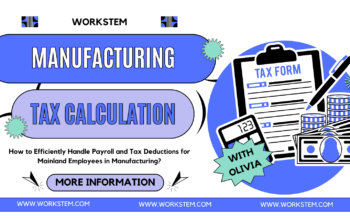Note for new boss/HR: MPF contribution calculation, this article will teach you how to disassemble MPF calculation method and how to calculate contributions in detail, including casual, long-term and part-time employees ; We will also explain different matters needing attention such as different ages, whether to pay MPF contributions after 60 days of employment.
In particular, many new start-ups owners fail to pay employee MPF regularly. Once the case is confirmed, MPFA has the right to levy a fine of HK$5,000 or 10% of the unpaid contributions on the employer! Failure to arrange MPF funds for employees is liable to a fine of HK$100,000 and imprisonment for up to six months upon first conviction!
罰金-1024x768-1-min.png)
How to calculate MPF contributions
1. In the period of 60 days, MPF calculation method of different cases (monthly salary)
For the calculation of contributions, both full-time and part-time employees are also divided on the basis of payment: monthly and non-monthly. The mandatory contributions of employers and employees are 5% of the relevant income, with no upper limit or lower limit. Keep in mind that the maximum mandatory contribution for either the employer or the employee is only HK$1,500 if the company has senior staff of HK$30,000 or more. The calculation method of monthly salary is simple:
| Monthly Relevant Income | Employer’s mandatory contributions | Employee’s mandatory contributions |
| Less than HK$7,100 | Relevant income x 5% | No contribution is required |
| HK$7,100 – HK$30,000 | Relevant income x 5% | Relevant income x 5% |
| More than HK$30,000 | HK$1,500 | HK$1,500 |
Example: Chen Dawan (male) is a secretary. He joined the company on 2021/02/23 and was employed for 60 days on 2021/04/24. His monthly salary is HK$10,000.
More than 60 days on the job: employer and employee contribution is 5% of relevant monthly income *
Employer’s contribution: HK$10,000*5%=HK$500;
Employee’s contribution: HK$10,000*5%=HK$500
Just 60 days on the job: 4.24 is the day of the first 60 days on the job, so April will be calculated as the first 60 days
Employer contribution: (April) HK$10,000*5%+ (March) HK$10,000*5%+ (6 days in February) +HK$10,000/28*6*5%=HK$500+HK$500+HK$107=HK$1,107
Employee contribution: HK$10,000*5%=500
Less than 60 days on the job: Neither employer nor employee is required to contribute
* If the employee Chen Dawen resigns before 2021/04/24, the employer and the employee do not need to make any contribution because the employee has been employed for less than 60 days
2. MPF Calculation method (monthly salary) for adults (18 years old and above) and retirees (65 years old and above)
Example 1: Chen Erwen is an intern who joined the company on 2020/02/23 and reached the age of 18 on 2021/03/05. However, he left the company on 2021/03/04. Neither the employer nor the employee (Chen Erwen) need to contribute
Example 2: Chen Sanwen is a President assistant. He joined on 2021/02/23, reached the age of 18 on 2021/03/05, and was employed for 60 days on 2021/04/24. His monthly salary is HK$8,000.
Just 18 years old: the employer does not need to make contributions in the current month (60 days after turning 18, you need to make contributions and add up MPF in the current month); Employee (Chen Sanwen) does not have to contribute (60 days after turning18)
Already turning 18 years old and employed for more than 60 days: the employer and employee contribution is 5% of relevant monthly income *
Employer’s contribution: HK$8,000*5%=HK$400;
Employee contribution: HK$8,000*5%=HK$400
Just turning 18 years old and less than 60 days of employment: both employer and employee (Chen Sanwen) need to make contribution
Example 3: John is a sales manager. He joined on 2021/02/23, turned 65 on 2021/03/06, and left after 60 days on 2021/04/24. His monthly salary is HK$20,000.
If the employee has just turned the age of 65 and left after 60 days of employment, the employee’s contribution is 5% of the MPF relevant income of the month, and the employer’s contribution is based on the working days pro rata
Employer’s contribution :(6 days in March) HK$20,000/31*6*5%+ (6 days in February) +HK$20,000/28*6*5%=HK$193.55+HK$214.29=HK$407.84
Employee’s contribution: HK$20000*5%=HK$1000
Example 4: David is a director. He joined on 2021/01/01, employed for 60 days on 2021/03/01, turned 65 on 2021/3/10, and left on 2021/03/20. His monthly salary is HK$30,000
10 days after turning 65: both employer and employee are calculated on a pro rata according to the number of working days
Employer’s contribution: (January) HK$30000 + (February) HK$30000 * 5% + 10 days (March) HK$30000/31 * 10 * 5% = HK$1500 + HK$1500 + HK$483.87 = HK$3483.87
* No contribution is required for employees aged 65 under the Employment Ordinance; No contribution is required for employees less than 60 days of employment
3. Calculation method of Non-monthly Salary (2 steps)
If the employee’s salary is calculated on a daily or weekly basis, the employer should first calculate the relevant income upper and lower limits at the minimum of HK$280 and maximum of HK$1,000 per day, and then make contributions according to the upper and lower limits.
Example: Iris is a part-time cashier and her employer pays her weekly
Iris’s minimum income for one week is HK$1,960 (HK$280*7); HK$7000 (HK$1000*7)
| A week’s relevant income | Employer’s Mandatory Contribution | Employee’s Mandatory Contribution |
| Less than the minimum level (HK$1,960) | Relevant income x 5% | No contribution is required |
| Between the minimum and maximum levels (HK$1,960 to HK$7,000) | Relevant income x 5% | Relevant income x 5% |
| More than the maximum level (HK$7,000) | HK$350 | HK$350 |
Assuming that Iris only worked for two days last week, her salary was HK$280 on Monday and HK$360 on Wednesday, Iris earned a total of HK$640
Employer’s contribution: HK$640*5%=HK$32; No contribution is required for Iris
* Temporary workers (Applicable to industry schemes) are paid on a daily basis and have different periods of employment. Therefore, they have their own unique contribution calculation method.
| Monthly Relevant Income | Employer’s Mandatory Contribution | Employee’s Mandatory Contribution |
| HK$280以下 | HK$10 | No contribution is required |
| HK$280-HK$350 | HK$15 | HK$15 |
| HK$350-HK$450 | HK$20 | HK$20 |
| HK$450-HK$550 | HK$25 | HK$25 |
| HK$550-HK$650 | HK$30 | HK$30 |
| HK$650-HK$750 | HK$35 | HK$35 |
| HK$750-HK$850 | HK$40 | HK$40 |
| HK$850-HK$950 | HK$45 | HK$45 |
| More than HK$950 | HK$50 | HK$50 |
MPF schemes for self-employed person
As long as you are over the age of 18 and under the age of 65, and earn income through the generation of services or trading of goods, you are self-employed and you need to register yourself for an MPF scheme.
In recent years, thanks to the convenience of online shopping, many people have started their own businesses. In the initial stage, in order to save costs, he did not hire employees, nor did he pay regular salary for himself. They simply withdraw part of their profits as income from time to time. In this way, it’s easy to ignore MPF. However, you need to formalise your income by opening an MPF account for yourself as a self-employed person. The advantage is that if you buy a house/car, you will be eligible for a bank mortgage only if you have a formal income document. It is also convenient to apply for different government funding schemes.
The MPF scheme processing procedures for self-employed persons are similar to the enterprise’s master trust scheme procedures. Self-employed persons are required to open an MPF self-employed person account with the trustee and complete the registration procedures within 60 days. The most special thing is that self-employed person can choose their own contribution deadline. For example, you can choose the 16th of each month as your contribution deadline, as long as you make contributions before the 16th of each month on time; You can also make annual contributions which are due on the last day of the financial year. Contributions are discretionary. If you earn more than HK$30,000 per month, the mandatory contribution is only HK$1,500. Of course, you can contribute more, which is an additional voluntary contribution. If someday the company becomes powerful enough for paying regular salaries and hiring employees, he could turn it into a master trust scheme and start the company’s MPF scheme.
Note: ** Exempt persons are not required to join an MPF scheme, including domestic employees, self-employed hawkers,people covered by statutory pension or provident fund schemes, members of occupational retirement schemes which have been granted MPF exemption certificates, overseas persons who enter Hong Kong under section 11 of the Immigration Ordinance for the purpose of employment for not more than 13 months, or who are covered by overseas retirement schemes, and employees of the European Union Office of the European Commission in Hong Kong.
To sum up, whether you are an employer or a self-employed person, you need to make MPF contributions. HR uses Excel to calculate the steps that are complicated and prone to errors. However, the HR system — the payroll of Workstem can automatically calculate payroll and automatically generate payslips, which can meet different salary types and pay periods, and achieve the whole process from calculation to payment for all employees in the company without worrying. The employer can also check the details of the monthly MPF settlement after payment.
Read More:
Should Part-time Employees Also Enroll in the MPF Scheme?
How to Calculate the Amount of MPF Contributions for Non-monthly-paid Employees?







